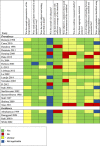Global prevalence of childhood cataract: a systematic review
- PMID: 27518543
- PMCID: PMC5023808
- DOI: 10.1038/eye.2016.156
Global prevalence of childhood cataract: a systematic review
Abstract
Childhood cataract is an avoidable cause of visual disability worldwide and is a priority for VISION 2020: The Right to Sight. There is a paucity of information about the burden of cataract in children and the aim of this review is to assess the global prevalence of childhood cataract. The methodology for the review followed the Preferred Reporting Items for Systematic Reviews and Meta-Analyses (PRISMA) guidelines. We performed a literature search for studies reporting estimates of prevalence or incidence of cataract among children (aged<18 years) at any global location using the Cochrane Library, Medline and Embase up to January 2015. No restrictions were imposed based on language or year of publication. Study quality was assessed using a critical appraisal tool designed for systematic reviews of prevalence. Twenty prevalence and four incidence studies of childhood cataract from five different geographical regions were included. The overall prevalence of childhood cataract and congenital cataract was in the range from 0.32 to 22.9/10000 children (median=1.03) and 0.63 to 9.74/10000 (median=1.71), respectively. The incidence ranged from 1.8 to 3.6/10000 per year. The prevalence of childhood cataract in low-income economies was found to be 0.42 to 2.05 compared with 0.63 to 13.6/10000 in high-income economies. There was no difference in the prevalence based on laterality or gender. This review highlights substantial gaps in the epidemiological knowledge of childhood cataract worldwide, particularly from low and lower middle-income economies. More studies are needed using standard definitions and case ascertainment methods with large enough sample sizes.
Figures



References
-
- Gralek M, Kanigowska K, Seroczynska M. Cataract in children—not only an ophthalmological problem. Med Wieku Rozwoj 2007; 11(2 Pt 2): 227–230. - PubMed
-
- Foster A, Gilbert C, Rahi J. Epidemiology of cataract in childhood: a global perspective. J Cataract Refract Surg 1997; 23(Suppl 1): 601–604. - PubMed
-
- Gilbert CE, Canovas R, Kocksch de Canovas R, Foster A. Causes of blindness and severe visual impairment in children in Chile. Dev Med Child Neurol 1994; 36(4): 326–333. - PubMed
Publication types
MeSH terms
LinkOut - more resources
Full Text Sources
Other Literature Sources
Medical

